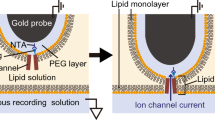Abstract
We present a micro fluidic chip for parallel ion channel recording in a large array of artificial planar lipid bilayer membranes. To realize a composite structure that features an array of recording wells with free-standing microapertures for lipid bilayer reconstitution, the device was fabricated by the hybrid stereolithography technology, in which a Parylene film with pre-formed microapertures was inserted during the rapid stereolithography process. We designed and tested a hybrid chip that has 96 (12×8) addressable recording wells to demonstrate recording of ion channel current in high-throughput manner. Measurement was done by sequentially moving the recording electrode, and, as a result, the channel current of model membrane protein was detected in 44 wells out of 96. We also showed that this hybrid fabrication process was capable of integrating micropatterned electrodes suitable for automated recording. These results support the efficiency of our present architecture of the parallel ion channel recording chip toward realization of the high-throughput screening of ion channel proteins in the artificial lipid bilayer system.







Similar content being viewed by others
References
A. Brueggemann, M. George, M. Klau, M. Beckler, J. Steindl, J.C. Behrends et al., Curr. Drug Discov. Technol. 1, 91–96 (2004), doi:10.2174/1570163043484833
J. Denyer, J. Worley, B. Cox, G. Allenby, M. Banks, Drug Discov. Today 3, 323–332 (1998), doi:10.1016/S1359-6446(98)01199-4
Y. Fang, A.G. Frutos, B. Webb, Y. Hong, A. Ferrie, F. Lai, et al. Biotechniques. (Suppl) 62–65 (2002)
N. Fertig, R.H. Blick, J.C. Behrends, Biophys. J. 82, 3056–3062 (2002)
J.T. Groves, Curr. Opin. Drug Discov. Devel. 5, 606–612 (2002)
J. Hallborn, R. Carlsson. Biotechniques (Suppl), 30–37 (2002)
K. Ikuta, T. Hasegawa, T. Adachi, S. Maruo. Fluid drive chips containing multiple pumps and switching valves for biochemical IC family. Proc. Int. Conf. MEMS, 739–744 (2000).
K. Ikuta, S. Maruo, T. Fujisawa, A. Yamda, Micro concentrator with opto-sense micro reactor for biochemical IC ship family. Proc. Int. Conf. MEMS, 376–381 (1999).
T. Kodadek, Chem. Biol. 8, 105–115 (2001), doi:10.1016/S1074-5521(00)90067-X
M. Kreir, C. Farre, M. Beckler, M. George, N. Fertig, Lab Chip. 8, 587–595 (2008), doi:10.1039/b713982a
M. Mayer, J.K. Kriebel, M.T. Tosteson, G.M. Whitesides, Biophys. J. 85, 2684–2695 (2003)
C. Miller. Ed., Ion Channel Reconstitution (Plenum Pub. Corp., New York, 1986).
R. Pantoja, D. Sigg, R. Blunck, F. Bezanilla, J.R. Heath, Biophys. J. 81, 2389–2394 (2001)
M.C. Peterman, J.M. Ziebarth, O. Braha, H. Bayley, H.A. Fishman, D.M. Bloom, Biomed Microdev. 4, 231–236 (2002)
B.L. Pioufle, H. Suzuki, K.V. Tabata, H. Noji, S. Takeuchi, Anal Chem 80, 328–332 (2008)
M.E. Sandison, H. Morgan, J Micromech Microeng 15, S139–S144 (2005)
M.E. Sandison, M. Zagnoni, H. Morgan, Langmuir 23, 8277–8284 (2007)
H. Suzuki, K. Tabata, Y. Kato-Yamada, H. Noji, S. Takeuchi, Lab Chip 4, 502–505 (2004)
H. Suzuki, K.V. Tabata, H. Noji, S. Takeuchi, Langmuir 22, 1937–1942 (2006)
H. Suzuki, K.V. Tabata, H. Noji, S. Takeuchi, Biosens Bioelectron 22, 1111–1115 (2007)
H. Suzuki, S. Takeuchi, Anal Bioanal Chem, Online First, (2008)
C. Wood, C. Williams, G.J. Waldron, Drug Discov Today 9, 434–441 (2004)
J. Xu, X. Wang, B. Ensign, M. Li, L. Wu, A. Guia, J. Xu, Drug Discov Today 6, 1278–1287 (2001)
M. Zagnoni, M.E. Sandison, P. Marius, A.G. Lee, H. Morgan, Lab Chip 7, 1176–83 (2007)
Author information
Authors and Affiliations
Corresponding author
Additional information
An erratum to this article can be found at http://dx.doi.org/10.1007/s10544-008-9218-z
Electronic supplementary material
Below is the link to the electronic supplementary material.
Fig. S1
Raw data of recordings of two sweeps. Upper and lower frames in each address show the result from the 1st and 2nd sweeps, respectively. Empty circle represents the event in which good electrical sealing was achieved, but no gramicidin signal was detected (case A in the main text). × represent the event in which electrical sealing was low (case B). Raw signal data is shown in the cases where the gramicidin signal was detected. (DOC 1.58 MB)
Rights and permissions
About this article
Cite this article
Suzuki, H., Pioufle, B.L. & Takeuhci, S. Ninety-six-well planar lipid bilayer chip for ion channel recording Fabricated by hybrid stereolithography. Biomed Microdevices 11, 17–22 (2009). https://doi.org/10.1007/s10544-008-9205-4
Published:
Issue Date:
DOI: https://doi.org/10.1007/s10544-008-9205-4




